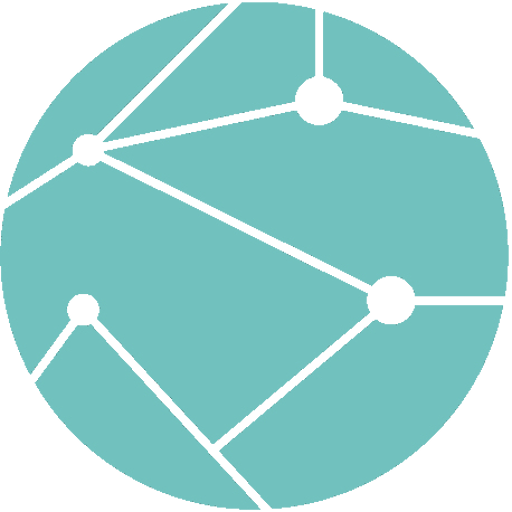SILMAR
IBERIAN MONITORING NETWORK
OF THE MARINE COASTLINE
“Preserving the marine environment contributing to the millennium goals”
Introduction
Recently, the 101-year-old scientist James Lovelock, (a NASA scientist who raised the famous Gaia theory) has expressed “The Biosphere and I have less than 1% life left”. An expression that should make us reflect on the reality of the world and to be more responsible with the planet. Today we live in moments of great social and economic uncertainty that actually has its origin in a profound ecological crisis on a global scale that began decades ago. Today, the planet is eminently human and our future will largely depend on our ability to cooperate to ensure the common good and that of the Earth. The sea is essential for our well-being due to the numerous and vital ecosystem services it offers us. There are indicators that show the ecological situation of our seas and by analyzing the state of the Mediterranean we will understand what is really happening in the great planetary ocean.
The Mediterranean is one of the most legislated seas in the world and on paper 6.01% of its surface is protected, an unrealistic reality if we analyze the low level of effectiveness in complying with these agreements. Scientists affirm that in order to avoid the loss of ecological and environmental quality of the Mediterranean, it is essential that at least 21% of its marine surface be well protected, including pelagic zones and biological corridors (Ventura, M.; Med & Law Project, 2018, Fundación Abertis). Recent publications derived from indicator control and monitoring programs in marine protected areas have shown that the level of protection effectiveness is actually less than 1%.
The factors that most directly influence the loss of quality of the sea and therefore of our lives are well known and are the result of our development model: pollution in general, overfishing, loss of natural capital, human pressure, mass tourism, etc. They are, in general, growing anthropogenic activities associated with a high environmental impact derived from the generation of waste and the high consumption of natural resources. An erratic process that translates into more greenhouse gas emissions and an increase in the annual per capita ecological footprint.
Overpopulation, the development model, poorly conceived education and the old political systems that still prevail in the world make our civilization approach an existential precipice from which it will be difficult to emerge if we do not react in time. Faced with this reality and with the idea of proceeding correctly to ensure our future, it is transcendental to open our eyes and attend to experts with vision and experience on what to do and how to reorient our difficult relationship with the nature of the planet. It is obvious that the more clean and virgin natural space there is on Earth, the better our future will be and that of millions of living beings who also share their existence with us. But on an eminently human planet, that is increasingly difficult and therefore we must be consistent and intelligent to adapt and survive.
Currently there are good initiatives designed to address the critical challenges that we must solve. Initiatives that intelligently and strategically integrate the concept of balanced and sustainable eco-social development. This means that the conservation of natural assets used (and not exploited) must be prioritized to ensure the maintenance of ecosystem services. This generates economic activities that are respectful of nature that allow the progress and well-being of its inhabitants in a lasting way.
The Silmar project is one of those interesting initiatives of great value for what it integrates and offers wherever it is implemented and developed. An initiative that was designed with the aim of transmitting to society the value of the natural heritage of the Mediterranean coast and promoting its conservation with the active participation of social agents linked to the marine environment.
During the first years of work, we have gained enough experience to gradually adapt the project to the needs of each area where it has been implemented, corroborating its enormous usefulness and positive impact. The Silmar project has evolved and currently integrates the necessary study protocols to detect the quality of the marine environment, its biodiversity and the impacts and pressures that the analyzed areas receive (pollution, effects of climate change, etc.). Silmar also has established the basic channels for transmitting knowledge to society with the aim of promoting social participation actions to achieve the active conservation of biodiversity and natural heritage through local communities.
What is the Silmar project?
Silmar is a network of underwater stations located along the Catalan and Balearic coast whose objective is to know and identify the marine environment ecologically, diagnose its environmental quality, value its biodiversity, as well as establish lasting conservation actions. Silmar is also a formidable initiative to achieve a more effective protection of the marine environment as it links local society and companies in the active conservation of nature through education, training, volunteering and marine stewardship.
Currently, the Silmar network integrates volunteers, local entities and companies with a vision of the future who understand that investing in the common good and in the protection of the sea is synonymous with knowledge, progress, and well-being.

Image 1. On the sea front of the municipality of Castell – Platja d’Aro (Costa Brava, Girona), at a depth of 15 metres, one of the monitoring stations of the Silmar Network is located, where there is an extraordinary and unknown biodiversity. (Photo: Miquel Ventura).
How we work and with what objectives
With the aim of permanently diagnosing the ecological status of the marine coastline at a local and regional scale, marine areas of ecological and social interest are selected to work on them collaboratively. Over the last few years, the Silmar Network has been increasing its control stations, and today we have nineteen spread over sixteen municipalities on the Catalan coast, two in Ibiza and one in Formentera.
Currently, some of the stations operate at a minimum or are inactive due to lack of financial resources as a result of the health and socioeconomic crisis that we are experiencing.
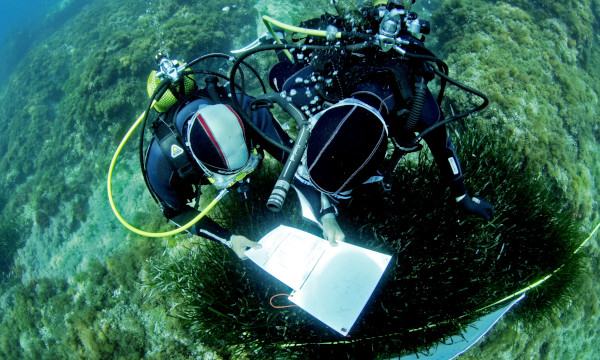
Image 2. Experienced biologists carefully record data from underwater observations in a limited time frame to avoid decompression.
Photography by Carles Virgili – Risk
The main objectives of the Silmar project are:
- Actively contribute to the conservation of marine and coastal biodiversity in target areas at a local and regional scale.
- Promote from the academic world the systematic study of marine habitats and ecosystems, placing special emphasis on the economic and ecological value of ecosystem services.
- Contribute to adaptation and eco-social resilience against the effects of climate change.
- Promote the concept of natural capital and blue economy in local agents.
- Disseminate the knowledge acquired to the local society to involve them in the active and collaborative conservation of the environment and the sea.
- In the medium term, consolidate the Silmar Network on the Spanish coast and in the long term in the western Mediterranean.
The actions carried out within the scope of the Silmar project allow us to acquire direct knowledge of the ecological state of the coastal marine environment, detect environmental impacts, discover trends in change and also assess the level of compliance with existing regulations on management and nature conservation by the different public administrations, coastal agents and society in general. Next, the level of connection established through the knowledge acquired in the Silmar network with the different agents and organizations that interact with the coast from different aspects is shown in the flowchart.

Action program at Silmar stations
Each Silmar station has been selected by our experts in a specific way, assessing parameters such as its location, ecological and environmental value, its level of resilience, its value in the local culture and also the willingness of the population to get involved in an action project for the conservation of its natural environment. In this context, all the Silmar Network stations meet some of these requirements.
Once the station is selected, a collaboration agreement is established with the local administration that determines the necessary agreements to guarantee the operation of the project and the associated activities, including the annual work calendar and objectives, the assigned budget, the preparation of the annual report (Silmar.doc ) and, among others, the training of volunteers, the incorporation of university students and the dissemination of the knowledge acquired to society.
The action program of the Silmar project by stages is specified in the diagram below.
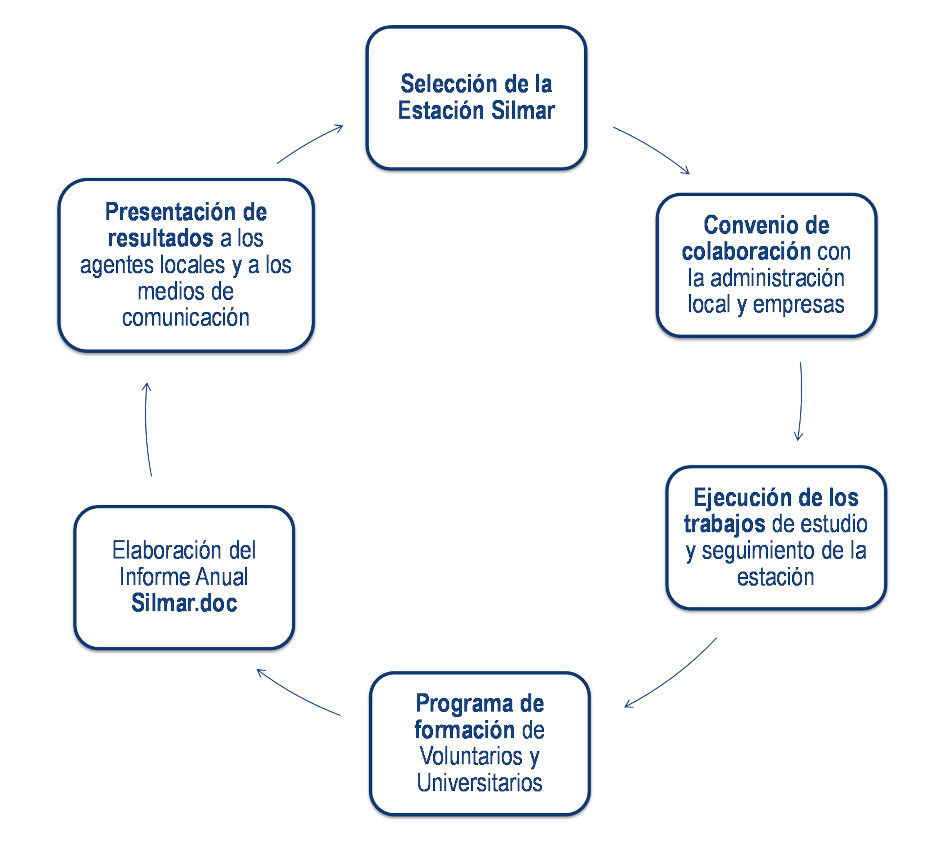
Results obtained
Let us analyse in a simplified way the results obtained to date within the framework of the Silmar project, and for this we must approach it from four different areas: the strictly scientific, the informative, the training and the strategic relationship with the local and regional public administration.
a) From a more academic point of view, the results of the project focus on the selection and adaptation of reference scientific protocols for the description of the seabed, its biological characterization, as well as the selection of quality bioindicators for periodic monitoring of coastal marine waters, of target species and habitats. In this area and throughout the first years of the project, we have managed to determine more than 850 different marine species, characterize the main marine habitats of the western Mediterranean and determine their ecological status, detect the presence of 15 invasive marine species, carry out 120 reports Silmar.doc and draw up 26 ecological and environmental improvement plans for the Network stations that have already been implemented.
b) At an informative and communication level, the annual publications of the Silmar.doc reports of each station have been presented to the media and society in general from the World Trade Center of the Port of Barcelona. This entity has regularly collaborated with the Silmar project, financing for 3 years a station located on the new southern jetty of the mouth of the Llobregat river and has also offered us its facilities for the annual presentation of the project’s results, achieving significant media coverage at the national.
c) On an educational level, apart from training the volunteers at each station, which total more than 170 between Catalonia and the Balearic Islands, we have established agreements with four universities nationwide to integrate their students in carrying out business internships and also Final Degree Projects (TFG) and Master’s Final Projects (TFM). This experience has been very positive since we have established lines of study to delve into aspects of interest to the Silmar project, such as the adaptation of scientific protocols on the effects of climate change on marine species, the analysis of the quality of marine water through of benthic bioindicators or also studies to detect the presence of microplastics in beach sand and in the water column, quantifying the derived ecological impacts.
d) All this valuable information must be transmitted to the public entities that have competences in the management and conservation of coastal marine spaces. The objective is for them to use this knowledge to establish better strategies and good management policies for the marine spaces that they directly or indirectly manage or use. In this context, in 2016 we managed to establish a marine stewardship agreement between the Sant Feliu de Guíxols City Council and the Generalitat de Catalunya to protect two marine areas of 80 ha. in the Red Natura 2000.
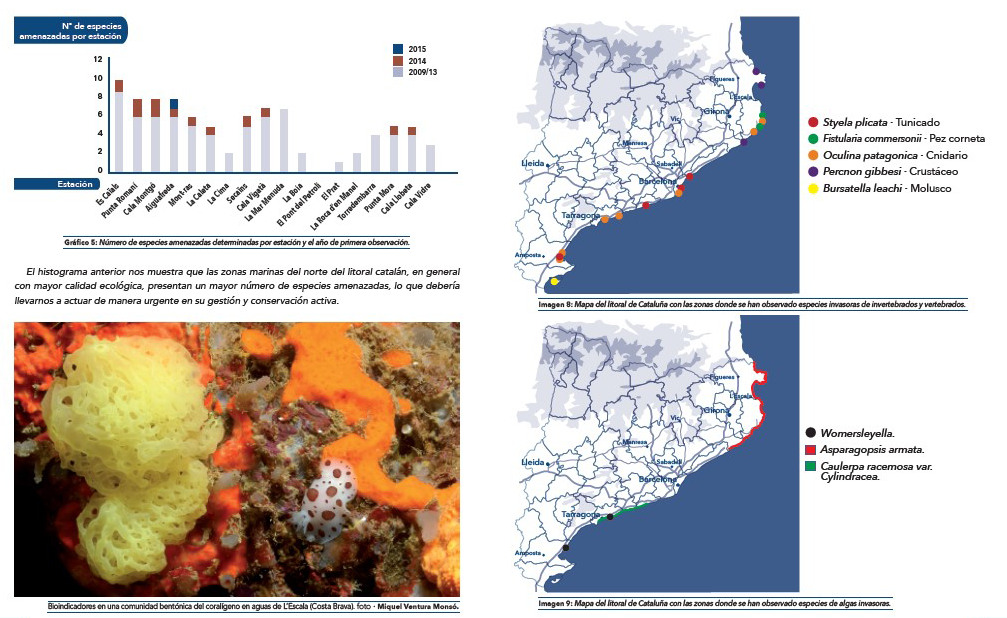
Example of the results that are exposed in the Silmar.doc annual reports of each control station. Data of interest is also collected at the level of the entire Catalan coast, as is the case of the presence of invasive species along the coast.
Adopt an impact project integrating the millennium SDGs
The society based on sustainable development, innovation and new technologies has understood that the new economy depends directly on the health of the environment on a global scale and this is where the world’s seas play an essential role. The Silmar project was devised by the marine biologist and collaborator of the RAED Miquel Ventura Monsó, as a response to the serious situation of neglect and poor management of the coastal and marine environment that is carried out in Spain and in general throughout the Mediterranean and the seas of the world.
The Silmar initiative converges perfectly with the objectives of the Sustainability Campus of the RAED Foundation, which seeks valid proposals that contribute to covering the social and political deficiencies that hinder the conservation of the marine and coastal environment at a local and regional scale. A process that requires clear and committed actions to face the important challenges that affect the Mediterranean ecosystem and all our lives.
Now, from within our organization we have the opportunity to get involved, from an academic perspective, in this project that brings us closer to the environmental reality of our surroundings, allowing us to act in the conservation of this natural heritage of inestimable value, getting involved in the consolidation of the culture of sustainability and participate directly in the processes of collective adaptation and mitigation of the effects of climate change.
Silmar and its convergence with the SDGs of the millennium
The Silmar project is the result of experience and action against the vicissitudes and impacts that this vital marine environment suffers as a result of human presence, therefore its design and conception integrates all those elements that are necessary to act in favour of conservation of the coastal sea at a local scale. In addition, we now have the opportunity to take advantage of the Silmar initiative to meet some of the millennium SDGs.
In 2015, the UN approved the 2030 Agenda for Sustainable Development, a new opportunity for the world’s societies to undertake the correct journey to correct the uncertain destiny of humanity. The Agenda has 17 Sustainable Development Goals (SDGs), which include major challenges such as the fight against climate change, poverty reduction, protection of biodiversity and the seas, education, women’s equality, the defence of the environment and, among others, the redesign of our cities. The following diagram lists the areas where the Silmar project mainly affects and its convergence to directly contribute to 7 of the 17 SDGs of the millennium.
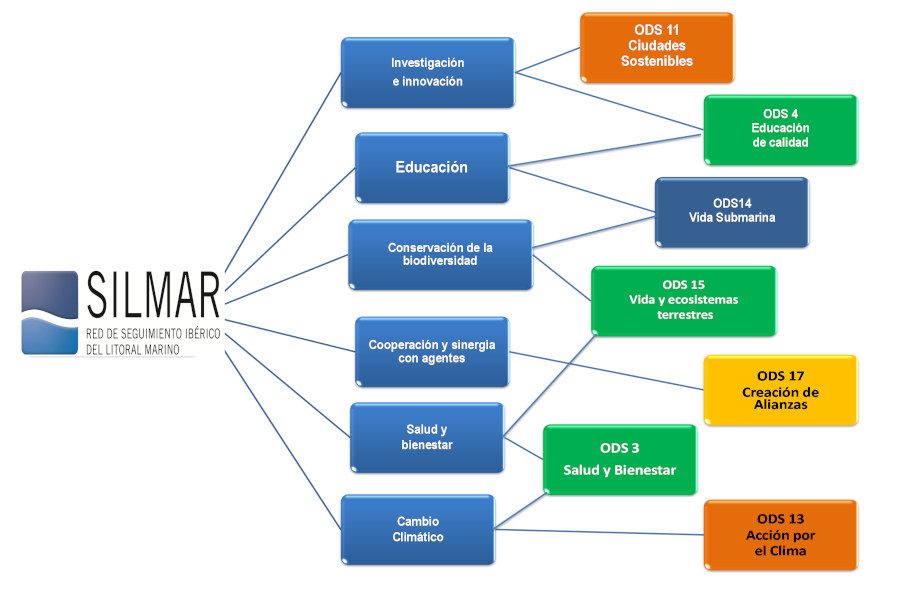
The new stage Silmar
Silmar begins a new stage by integrating itself as one of the main projects that the RAED Foundation will promote and in this first stage it is working on the development of the executive project for the period 2020-2022 that will integrate the following points: adjustment of the number of stations network control and scientific objectives; integration of RAED academics in the field of ecology, the environment, AI and Big Data; renewal of agreements with municipalities, companies and donors; online training program for volunteers and university students; new format of the Silmar.doc annual reports; creation of project content on the RAED Foundation website and, among other actions, a fundraising program.
The coastal and marine ecosystem is synonymous with wealth and well-being and is a great source of knowledge for the progress of our society. For these and other reasons it is vital to preserve it and ensure this legacy of which we are only usufructuaries for future generations. Now, and thanks to the Silmar project, we can contribute to successfully overcoming this great challenge and demonstrate to society that with a firm change of attitude, the intelligent use of knowledge and the creation of synergies between people and entities, we can prosper towards human excellence.

